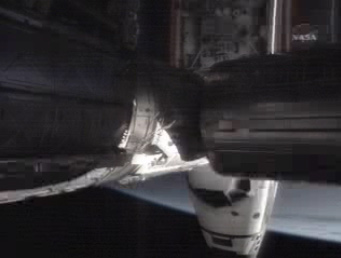Shuttle Astronauts Gear Up for First Spacewalk

This story was updated at 11:37 a.m. ET.
Astronauts are gearing up for a spacewalk Saturday to preparea new Japanese research porch to be installed on the space station.
In the first spacewalk of the shuttle Endeavour's STS-127mission, NASA astronauts Dave Wolf and Tim Kopra are due to step out into spaceat 11:58 a.m. EDT (1558 GMT). During the planned six-and-a-half hour activity,the two spacewalkers will unberth theporch - a platform to expose science experiments to the space environment -from the shuttle's cargo bay and prepare its attachment site at the station'smassive JapaneseKibo laboratory.
"The time critical task that Tim and I will do on thefirst spacewalk of the mission, Day 4, is to get that exposed facility, theJapanese 'Jeff' exposed facility, ready to be unberthed robotically out of thepayload bay," Wolf said in a preflight interview. "This is achoreography between the spacewalk crew, of course the ground and the roboticsarm operators."
The two spacewalkers began preparing for today's event bycamping out in the station's Quest airlock overnight, where the pressure waslowered to prepare their bodies for wearing the spacesuits today.
Wolf, aveteran astronaut with four spacewalks under his belt, will wear aspacesuit marked with a red stripe. Kopra, making his spacewalking debut, will wearan all-white suit.
"I'm really excited," Kopra said of his firstspacewalk experience. "It's going to be great. You know, both doing thespacewalk and being able to work the robotic arms on space station are very excitingcomponents of our mission for, for astronauts, and I think that?s going to bequite an event."
Breaking space news, the latest updates on rocket launches, skywatching events and more!
While those two are working outside, shuttle commander MarkPolansky, pilot Doug Hurley and mission specialists Julie Payette and KoichiWakata will operate the shuttle and station robotic arms to transfer the JapaneseExposed Facility to its new home on Kibo.
"I'm amazed by the operations team and the crew and thecomplexity of the missions we're operating now," NASA shuttle programmanager John Shannon said Friday. "The robotics required to support thosespacewalks is as complicated as we've ever done. We are very excited to getthis flight kicked off."
The two spacewalkers will alsowork to deploy two spare part platforms on the station's backbone-like truss. Theplatforms serve as a sort of exposed storage shed for vital station spareparts.
One of the platforms waspreviously attached during the STS-119 shuttle mission in March, but a jammedpin kept the platform from unfolding as it was meant to. Wolf and Kopra willgive it another try today.
Endeavour astronauts plan to perform five tricky spacewalksduring their mission. This trip is only the second time that so many spacewalkswill be conducted on a space station shuttle mission.
The spaceshuttle docked at the International Space Station Friday to begin atwo-week visit, boosting the population onboard the orbital outpost to a recordhigh of 13. Endeavour launched July 15 after more than a month of delays on theground.
- Video - The Expanding Danger of Space Debris
- New Video - The Kibo Lab: Japan's Hope in Space - Part 1, Part 2
- SPACE.com Special Report - THE MOON: Then, Now, Next
SPACE.com is providing continuous coverage of STS-127with reporter Clara Moskowitz and senior editor Tariq Malik in New York. Click here for missionupdates and SPACE.com's live NASA TV video feed.

Clara Moskowitz is a science and space writer who joined the Space.com team in 2008 and served as Assistant Managing Editor from 2011 to 2013. Clara has a bachelor's degree in astronomy and physics from Wesleyan University, and a graduate certificate in science writing from the University of California, Santa Cruz. She covers everything from astronomy to human spaceflight and once aced a NASTAR suborbital spaceflight training program for space missions. Clara is currently Associate Editor of Scientific American. To see her latest project is, follow Clara on Twitter.
